科普版英语四年级上册知识点
科普版四年级上重点知识
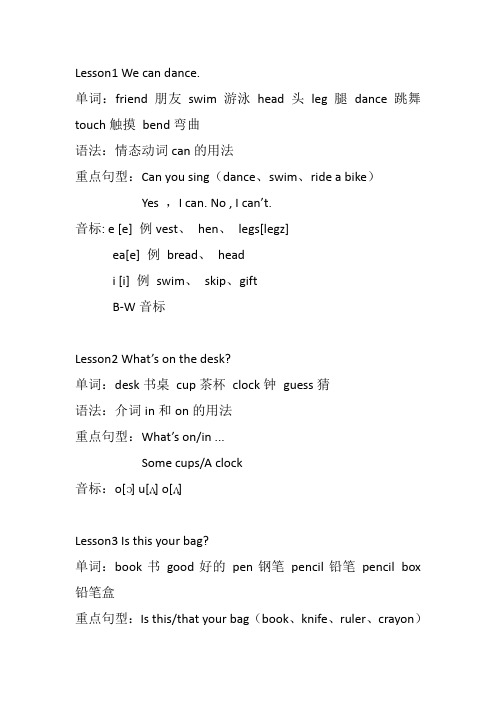
Lesson1 We can dance.单词:friend朋友swim游泳head头leg腿dance跳舞touch触摸bend弯曲语法:情态动词can的用法重点句型:Can you sing(dance、swim、ride a bike)Yes ,I can. No , I can’t.音标: e [e] 例vest、hen、legs[legz]ea[e] 例bread、headi [i] 例swim、skip、giftB-W音标Lesson2 What’s on the desk?单词:desk书桌cup茶杯clock钟guess猜语法:介词in和on的用法重点句型:What’s on/in ...Some cups/A clock音标:o[ɔ] u[ʌ] o[ʌ]Lesson3 Is this your bag?单词:book书good好的pen钢笔pencil铅笔pencil box 铅笔盒重点句型:Is this/that your bag(book、knife、ruler、crayon)Yes, it is. No, it isn’t音标:oo[u]Lesson4 Is he your brother?单词:father、mother、family、girl重点句型:Who’s he/she?He/She is my brother/sister.音标:a[æ] er[ə] th[ð]Lesson5 What can you see?单词:room、schoolbag、read、green、tree、any、four、they、sheep重点句型:What can you see?I can see a tree/car/pig/box.Can you see a sheep/ship/panda/fox.Yes, I can. No, I can’t.音标:ee,ea[i:] oo,o[u:] sh[ʃ]Lesson6 Revision单词:from、brown、nowLesson7 Is she a doctor or a nurse?单词:teacher, worker, woman, doctor, or, nurse重点句型:Is he/she a doctor? Yes, he/she is. No, he/she isn’t.Is he/she a doctor or a nurse? He/she is a doctor. 语法:关于职业的一般疑问句及肯否回答。
【精编】科普版四年级英语上册期末复习知识点
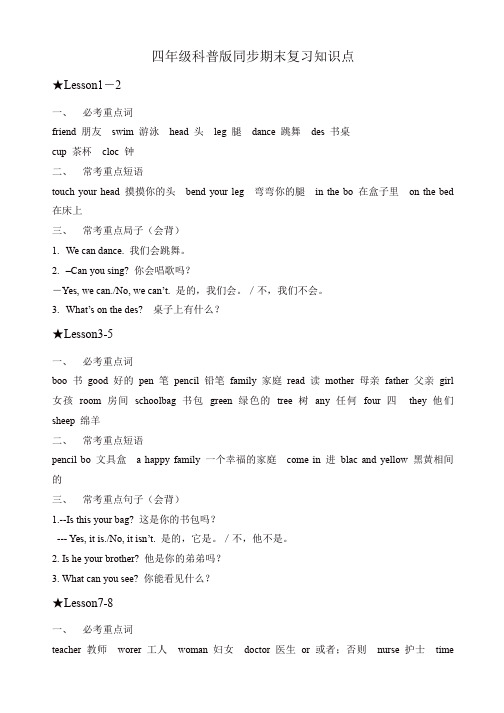
四年级科普版同步期末复习知识点★Lesson1-2一、必考重点词friend 朋友swim 游泳head 头leg 腿dance 跳舞des 书桌cup 茶杯cloc 钟二、常考重点短语touch your head 摸摸你的头bend your leg 弯弯你的腿in the bo 在盒子里on the bed 在床上三、常考重点局子(会背)1.We can dance. 我们会跳舞。
2.–Can you sing? 你会唱歌吗?-Yes, we can./No, w e can’t. 是的,我们会。
/不,我们不会。
3.What’s on the des? 桌子上有什么?★Lesson3-5一、必考重点词boo 书good 好的pen 笔pencil 铅笔family 家庭read 读mother 母亲father 父亲girl 女孩room 房间schoolbag 书包green绿色的tree 树any 任何four 四they 他们sheep 绵羊二、常考重点短语pencil bo 文具盒 a happy family 一个幸福的家庭come in 进blac and yellow 黑黄相间的三、常考重点句子(会背)1.--Is this your bag? 这是你的书包吗?--- Yes, it is./No, it isn’t. 是的,它是。
/不,他不是。
2. Is he your brother? 他是你的弟弟吗?3. What can you see? 你能看见什么?★Lesson7-8一、必考重点词teacher 教师worer 工人woman 妇女doctor 医生or 或者;否则nurse 护士time时间eight 八late 迟的Sunday 星期日二、常考重点短语a teacher 一个老师my sister 我的妹妹in the room 在房间里eight o’cloc 八点钟be late 迟到三、常考重点句子(会背)1.--Is she a doctor or a nurse? 她是一名医生还是一名护士?——She is a doctor. 她是一名医生。
最新科普版四年级上重点知识

Lesson1 We can dance.单词:friend朋友swim游泳head头leg腿dance跳舞touch触摸bend弯曲语法:情态动词can的用法重点句型:Can you sing(dance、swim、ride a bike)Yes ,I can. No , I can’t.音标: e [e] 例vest、hen、legs[legz]ea[e] 例bread、headi [i] 例swim、skip、giftB-W音标Lesson2 What’s on the desk?单词:desk书桌cup茶杯clock钟guess猜语法:介词in和on的用法重点句型:What’s on/in ...Some cups/A clock音标:o[ɔ] u[ʌ] o[ʌ]Lesson3 Is this your bag?单词:book书good好的pen钢笔pencil铅笔pencil box 铅笔盒重点句型:Is this/that your bag(book、knife、ruler、crayon)Yes, it is. No, it isn’t音标:oo[u]Lesson4 Is he your brother?单词:father、mother、family、girl重点句型:Who’s he/she?He/She is my brother/sister.音标:a[æ] er[ə] th[ð]Lesson5 What can you see?单词:room、schoolbag、read、green、tree、any、four、they、sheep重点句型:What can you see?I can see a tree/car/pig/box.Can you see a sheep/ship/panda/fox.Yes, I can. No, I can’t.音标:ee,ea[i:] oo,o[u:] sh[ʃ]Lesson6 Revision单词:from、brown、nowLesson7 Is she a doctor or a nurse?单词:teacher, worker, woman, doctor, or, nurse重点句型:Is he/she a doctor? Yes, he/she is. No, he/she isn’t.Is he/she a doctor or a nurse? He/she is a doctor. 语法:关于职业的一般疑问句及肯否回答。
科普版四年级英语上册全册知识点汇总

1. 名词: book书 pen钢笔 pencil铅笔
2. 形容词: good好的
3. 短语: pencil box文具盒
二、拓展词汇
1. 名词: ruler尺子 crayon蜡笔 knife 小刀 cook 厨师
2. 动词: read 读
三、核心句型
—Is this your knife? 这是你的小刀吗?
2. 动词: read读
3. 形容词: green绿色的
4. 数词: four四
5. 人称代词: they他们
6. 限定词: any一些
二、拓展词汇
1. 名词: car汽车 fox狐狸 ship轮船 pig猪 panda熊猫 bee蜜蜂
2. 动词: sleep睡觉
3. 形容词: busy忙碌的
4. 数词: three三
1. 名词: rain雨 plane飞机 day日子 zoo动物园
2. 动词: take带走
3. 数词: six六 eleven十一 twelve十二
4. 副词: again又
三、核心句型
—What's the time, please? 请问,几点了?
—It's eight o'clock. 八点了。
解读: 将look放在句首,用来引起他人的注意。类似的单词还有:listen。
2. Her name is Nell. 她的名字是内尔。
解读: 这是一个介绍某人名字的陈述句,通常用来回答“What’s her name?”。
Lesson 5 What can you see?
一、核心词汇
1. 名词: room房间 schoolbag书包 tree树 sheep绵羊
科普版四年级英语上册 Lesson 3 知识清单
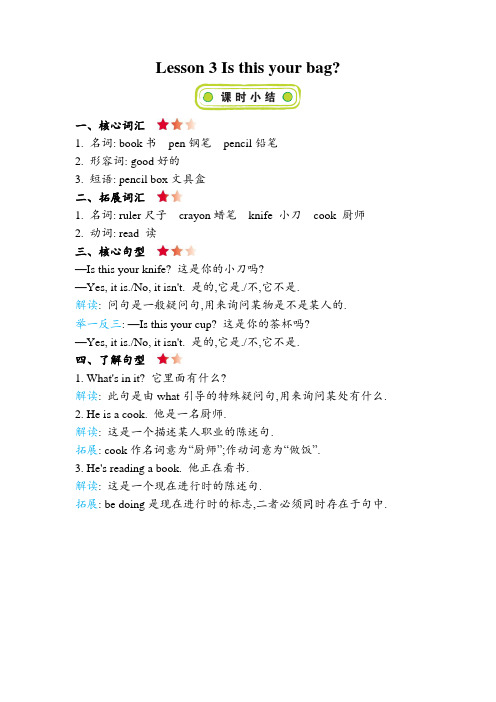
Lesson 3 Is this your bag?
一、核心词汇
1. 名词: book书pen钢笔pencil铅笔
2. 形容词: good好的
3. 短语: pencil box文具盒
二、拓展词汇
1. 名词: ruler尺子crayon蜡笔knife 小刀cook 厨师
2. 动词: read 读
三、核心句型
—Is this your knife? 这是你的小刀吗?
—Yes, it is./No, it isn't. 是的,它是./不,它不是.
解读: 问句是一般疑问句,用来询问某物是不是某人的.
举一反三: —Is this your cup? 这是你的茶杯吗?
—Yes, it is./No, it isn't. 是的,它是./不,它不是.
四、了解句型
1. What's in it? 它里面有什么?
解读: 此句是由what引导的特殊疑问句,用来询问某处有什么.
2. He is a cook. 他是一名厨师.
解读: 这是一个描述某人职业的陈述句.
拓展: cook作名词意为“厨师”;作动词意为“做饭”.
3. He's reading a book. 他正在看书.
解读: 这是一个现在进行时的陈述句.
拓展: be doing是现在进行时的标志,二者必须同时存在于句中.。
【教材知识点梳理】小学英语各册知识梳理-四年级上册 科普版

/əʊ/发音要领:/əʊ/是从 /ə/滑
动到/ʊ/的合口双元音,发/əʊ/音
语 时,先发 /ə/,再从 /ə/滑向 /ʊ/, √
√
√
音 双唇从略扁到圆,牙床从半开到
合,喉头肌肉松弛。
/aʊ/发音要领:/aʊ/是从 /a/滑 动到 /ʊ/的合口双元音。发 /aʊ/ 音时,先发 /a/,再滑到 /ʊ/,口 型从张开到圆唇,牙床从全开到
(-oo-, -o /uː/) room,who
(-sh- /ʃ/) fish,sheep
重 点 词 : room, schoolbag,
read, green, tree, any, four, √
√
√
√
词 they, sheep 汇
交通工具类:car,ship
√
√
√
Lesson 6
Revision
词 汇
白体词:pencil box 文具类:knife,ruler,crayon
√
√
√
√
√
√
√
句 Is this your knife?
型 Yes, it is./ No, it isn’t.
√
√
√
√
What’s in it?
元音音标: /æ/ /ə/ /ð/
/æ/发音要领:舌端抵下齿,前舌
稍高,但比发/ɪ/和/e/音时略低,
音 的 i 比/iː/略短,发 i 音时舌中部
比发/iː/音抬得高,带有一定的摩
擦,而/iː/音则不带任何摩擦。
/uː/发音要领:后舌抬得很高,
双唇收圆并稍突出,牙床近乎全
合,喉头肌肉紧张。 /uː/和 /ʊ/
Lesson 5
科普版四年级英语上册期末复习知识点-优选

四年级科普版同步期末复习知识点★Lesson1-2一、必考重点词friend 朋友swim 游泳head 头leg 腿dance 跳舞desk 书桌cup 茶杯clock 钟二、常考重点短语touch your head 摸摸你的头bend your leg 弯弯你的腿in the box 在盒子里on the bed 在床上三、常考重点局子(会背)1.We can dance. 我们会跳舞。
2.–Can you sing? 你会唱歌吗?-Yes, we can./No, we can’t. 是的,我们会。
/不,我们不会。
3.What’s on the desk? 桌子上有什么?★Lesson3-5一、必考重点词book 书good 好的pen 笔pencil 铅笔family 家庭read 读mother 母亲father 父亲girl 女孩room 房间schoolbag 书包green绿色的tree 树any 任何four 四they 他们sheep 绵羊二、常考重点短语pencil box 文具盒 a happy family 一个幸福的家庭come in 进来black and yellow 黑黄相间的三、常考重点句子(会背)1.--Is this your bag? 这是你的书包吗?--- Yes, it is./No, it isn’t. 是的,它是。
/不,他不是。
2. Is he your brother? 他是你的弟弟吗?3. What can you see? 你能看见什么?★Lesson7-8一、必考重点词teacher 教师worker 工人woman 妇女doctor 医生or 或者;否则nurse 护士time 时间eight 八late 迟的Sunday 星期日二、常考重点短语a teacher 一个老师my sister 我的妹妹in the room 在房间里eight o’clock 八点钟be late 迟到三、常考重点句子(会背)1.--Is she a doctor or a nurse? 她是一名医生还是一名护士?——She is a doctor. 她是一名医生。
科普版四年级英语上册期末复习知识点
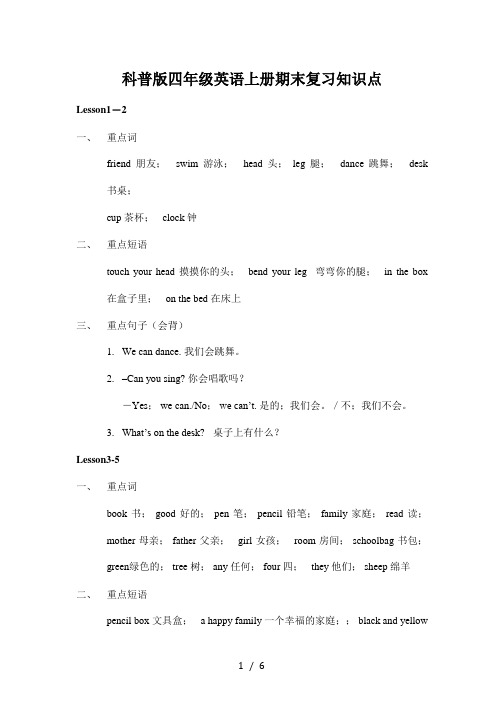
科普版四年级英语上册期末复习知识点Lesson1-2一、重点词friend 朋友;swim 游泳;head 头;leg 腿;dance 跳舞;desk 书桌;cup 茶杯;clock 钟二、重点短语touch your head 摸摸你的头;bend your leg 弯弯你的腿;in the box 在盒子里;on the bed 在床上三、重点句子(会背)1.We can dance. 我们会跳舞。
2.–Can you sing? 你会唱歌吗?-Yes; we can./No; we can’t. 是的;我们会。
/不;我们不会。
3.What’s on the desk? 桌子上有什么?Lesson3-5一、重点词book 书;good 好的;pen 笔;pencil 铅笔;family 家庭;read 读;mother 母亲; father 父亲;girl 女孩;room 房间; schoolbag 书包;green绿色的; tree 树; any 任何; four 四;they 他们; sheep 绵羊二、重点短语pencil box 文具盒; a happy family 一个幸福的家庭;; black and yellow黑黄相间的三、重点句子(会背)1.--Is this your bag? 这是你的书包吗?--- Yes; it is./No; it isn’t. 是的;它是。
/不;他不是。
2. Is he your brother? 他是你的弟弟吗?3. What can you see? 你能看见什么?Lesson7-8一、重点词teacher 教师;worker 工人;woman 妇女;doctor 医生;or 或者;否则nurse 护士;time 时间;eight 八;late 迟的;Sunday 星期日二、重点短语a teacher 一个老师;my sister 我的妹妹;in the room 在房间里;eight o’clock 八点钟;be late 迟到三、重点句子(会背)1.--Is she a doctor or a nurse? 她是一名医生还是一名护士?——She is a doctor. 她是一名医生。
科普版四年级英语上册 Lesson 5 知识点清单

Lesson 5 What can you see?
一、核心词汇
1. 名词: room房间 schoolbag书包 tree树 sheep绵羊
2. 动词: read读
3. 形容词: green绿色的
4. 数词: four四
5. 人称代词: they他们
6. 限定词: any一些
二、拓展词汇
1. 名词: car汽车 fox狐狸 ship轮船 pig猪 panda熊猫 bee 蜜蜂
2. 动词: sleep睡觉
3. 形容词: busy忙碌的
4. 数词: three三
5. 介词: under 在.....下
三、核心句型
1.—What can you see? 你能看到什么?
—I can see a tree. 我能看到一棵树。
解读: 问句是由特殊疑问词what引导的特殊疑问句,用来询问对方能看到什么。
举一反三: —What can the boy see? 这个男孩能看到什么?
—He can see a green bag.他能看到一个绿色的书包。
2. —Can you see a sheep? 你能看到一只绵羊吗?
—Yes, I can. 是的,我能。
解读: 问句是由can引导的一般疑问句,用来询问对方能否看到某物。
举一反三: —Can you see a ship? 你能看到一艘船吗?
—Yes, I can. 是的,我能。
四、了解句型
Please come in. 请进。
解读: 此句是一个祈使句。
please 可以使语气更加委婉。
【教材知识点梳理】小学英语各册知识梳理-四年级上册 科普版
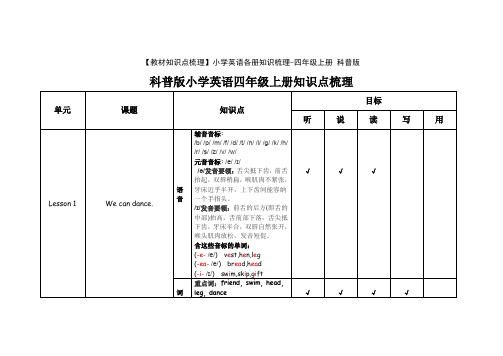
科普版小学英语四年级上册知识点梳理
单元
课题
知识点
目标
听
说
读
写
用
Lesson 1
We can dance.
语音
辅音音标:
/b//p//m//f//d//t//n//l//g//k/ /h//r//s//z//v//w/
元音音标:/e//ɪ/
/e/发音要领:舌尖抵下齿,前舌抬起,双唇稍扁,喉肌肉不紧张,牙床近乎半开,上下齿间能容纳一个手指头。
Look! This is my family.
√
√
√
√
Lesson5
What can you see?
语音
元音音标:/iː//uː/
辅音音标:/ʃ/
/iː/发音要领:前舌抬高,舌端抵下齿,双唇扁平,牙床几乎全开,喉头肌肉较紧张,它与汉语拼音中的i相似,但不相同,汉语拼音
的i比/iː/略短,发i音时舌中部比发/iː/音抬得高,带有一定的摩擦,而/iː/音则不带任何摩擦。
/ʌ/发音要领:后舌前部稍高,双唇向两边伸张,稍扁,牙床半开,喉头肌肉较紧张,它有一点像汉语拼音的a,但比a短促,且牙床只开到a音的2/3大小。
含这些音标的单词:
(-o-/ɒ/) clock,doll
(-u-/ʌ/) cup,uncle
(-o-/ʌ/) son,monkey
√
√
√
词汇
重点词:desk, cup, clock
Yes, it is./ No, it isn’t.
What’s in it?
√
√
√
√
Lesson4
科普版四年级英语上册全册单元知识点

科普版四年级英语上册全册单元知识点四年级英语上册 1-12课知识点汇总Lesson1:We can dance词汇汇总:小的游泳腿头小山朋友弯曲词组汇总:sing唱歌 dance跳舞 swim游泳 ride a bike 骑自行车知识点分析:的用法can 是情态动词后面跟动词原形,两个含义:①表示能力“能,会”②表示请求,许可“可以”变否定 can + not, 变疑问把 can 提前至句首.例子1.“能,会”:I /He can swim. (我/他会游泳。
)I/He can't swim. (我/他不会游泳。
其中can’t=can not )Can you/he swim?(你/他会游泳吗?)-----Yes, I/he can(肯定回答) (是的,我/他会./No, I/he can't. (否定回答/不,我/他不会。
)例子2.“可以”I can help you. 我可以帮助你Can you help me? 你可以帮助我吗?(一般疑问句,肯定回答 Yes, I/we can 是的,我们可以,否定回答No ,I/we can ’t不,我们不可以。
)Lesson2: What's on the desk?词汇汇总:什么书桌一些茶杯钟对不起来一猜,猜出词组汇总:on the bed 在床上 in the box 在盒子里 in the room 在房间里知识点分析:1.介词小结:介词是一种用来表示词与词,词与句之间的关系的词。
On在⋯上面(接触),under在..下面,In在⋯里面,behind在⋯后面,?in front of在⋯前面,beside 在⋯旁边。
2.名词单数变复数:名词单数变复数,直接加 -s 占多数;s, x, z, ch, sh 来结尾,直接加上 es;词尾是 f 或 fe,加 s 之前先变 ve;辅母 + y 在词尾,把 y 变 i 再加 es;词尾字母若是 o,常用三个已足够,要加 es 请记好,hero, tomato, potato 。
科普版四年级上册、下册的英语单词汇总
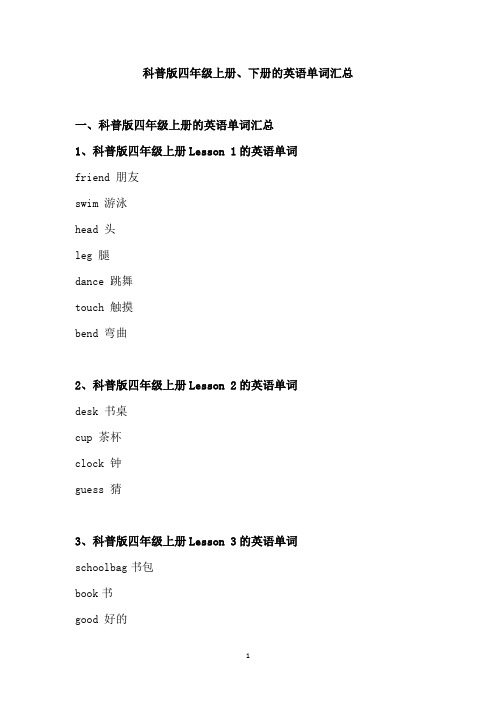
科普版四年级上册、下册的英语单词汇总一、科普版四年级上册的英语单词汇总1、科普版四年级上册Lesson 1的英语单词friend 朋友swim 游泳head 头leg 腿dance 跳舞touch 触摸bend 弯曲2、科普版四年级上册Lesson 2的英语单词desk 书桌cup 茶杯clock 钟guess 猜3、科普版四年级上册Lesson 3的英语单词schoolbag书包book书good 好的pen 钢笔pencil 铅笔pencil box文具盒4、科普版四年级上册Lesson 4的英语单词family 家庭mother母亲father 父亲girl女孩5、科普版四年级上册Lesson 5的英语单词room 房间read 读green 绿色的tree 树any 一些,任何four 四they 他们sheep 绵羊6、科普版四年级上册Lesson 6的英语单词from 从,来自brown 棕色的now 现在7、科普版四年级上册Lesson 7的英语单词teacher 教师worker 工人woman 妇女(复women)doctor 医生or 或者,否则nurse 护士8、科普版四年级上册Lesson 8的英语单词time 时间eight 八late 迟的Sunday 星期日o'clock ……点钟9、科普版四年级上册Lesson 9的英语单词house 房子horse 马beside 在……旁边six 六cow 奶牛eleven 十一twelve十二thirteen 十三fifteen 十五over 在那边;结束goat 山羊over there在那边how many多少10、科普版四年级上册Lesson 10的英语单词morning早晨,上午near在……附近here 这里under 在……下chair椅子dear亲爱的11、科普版四年级上册Lesson 11的英语单词bus 公共汽车car 小汽车aunt 姑,姨,舅母等plane 飞机jeep 吉普车Excuse me.对不起。
科普版四年级英语上册期末复习知识点-精华版

四年级科普版同步期末复习知识点★Lesson1-2一、必考重点词friend 朋友 swim 游泳 head 头 leg 腿 dance 跳舞 desk 书桌cup 茶杯 clock 钟二、常考重点短语touch your head 摸摸你的头 bend your leg 弯弯你的腿 in the box 在盒子里 on the bed 在床上三、常考重点局子(会背)1.We can dance. 我们会跳舞。
2.–Can you sing? 你会唱歌吗?-Yes, we can./No, we can’t. 是的,我们会。
/不,我们不会。
3.What’s on the desk? 桌子上有什么?★Lesson3-5一、必考重点词book 书 good 好的 pen 笔 pencil 铅笔 family 家庭 read 读 mother 母亲 father 父亲girl 女孩 room 房间 schoolbag 书包 green绿色的 tree 树 any 任何 four 四 they 他们 sheep 绵羊二、常考重点短语pencil box 文具盒 a happy family 一个幸福的家庭 come in 进来 black and yellow 黑黄相间的三、常考重点句子(会背)1.--Is this your bag? 这是你的书包吗?--- Yes, it is./No, it isn’t. 是的,它是。
/不,他不是。
2. Is he your brother? 他是你的弟弟吗?3. What can you see? 你能看见什么?★Lesson7-8一、必考重点词teacher 教师 worker 工人 woman 妇女 doctor 医生 or 或者;否则 nurse 护士time 时间 eight 八 late 迟的 Sunday 星期日二、常考重点短语a teacher 一个老师 my sister 我的妹妹 in the room 在房间里eight o’clock 八点钟 be late 迟到三、常考重点句子(会背)1.--Is she a doctor or a nurse? 她是一名医生还是一名护士?——She is a doctor. 她是一名医生。
科普版四年级英语上册 Lesson 4 知识清单

Lesson 4 Is he your brother?
一、核心词汇
名词: family家庭mother 母亲father 父亲girl 女孩
二、拓展词汇
名词: boy男孩sister 姐姐,妹妹brother 哥哥,弟弟
三、核心句型
—Who’s he? 他是谁?
—He’s my father. 他是我的爸爸.
解读: 问句是由特殊疑问词who引导的特殊疑问句,用来询问某人是谁.
举一反三: —Who is the boy? 这个男孩是谁?
—He's my brother. 他是我的弟弟.
四、了解句型
1. Look! This is my family. 看!这是我的家庭.
解读: 将look放在句首,用来引起他人的注意.类似的单词还有:listen.
2. Her name is Nell. 她的名字是内尔.
解读: 这是一个介绍某人名字的陈述句,通常用来回答“What’s her name?”.。
科普版英语四年级上册 Lesson 7 -8知识梳理

Lesson 7 Is she a doctor or a nurse?一、核心词汇1. 表示职业的名词: teacher教师worker工人doctor医生nurse护士2. 连词: or或者;否则3. 名词: woman妇女二、拓展词汇表示职业的名词: farmer 农民driver 司机三、核心句型—Is she a doctor or a nurse? 她是一个医生还是一个护士? .—She is a doctor. 她是一个医生。
解读: 问句是选择疑问句,用来让对方在两者中选择其一进行回答。
举一反三: —Is your mother a farmer or a worker? 你的妈妈是一个农民还是一个工人?—A worker. 一个工人。
四、了解句型—Are you a teacher? 你是一个老师吗?—No, I’m not.不,我不是。
解读: 问句用来询问某人是否从事某种职业。
Lesson 8 What’s the time?一、核心词汇1. 名词: time时间Sunday星期日2. 数词: eight八3. 形容词: late迟的4. 副词: o’clo ck ......点钟二、拓展词汇1. 名词: rain雨plane飞机day日子zoo动物园2. 动词: take带走3. 数词: six六eleven十一twelve十二4. 副词: again又三、核心句型—What's the time, please? 请问,几点了?—It's eight o'clock. 八点了。
解读: 这组对话是用来询问和回答时间的。
举一反三: —What's the time, please? 请问,几点了? —It's three o'clock. 三点了。
四、了解句型1. I'm late again. 我又迟到了。
解读: 此句是陈述句,用来表达自己迟到了。
- 1、下载文档前请自行甄别文档内容的完整性,平台不提供额外的编辑、内容补充、找答案等附加服务。
- 2、"仅部分预览"的文档,不可在线预览部分如存在完整性等问题,可反馈申请退款(可完整预览的文档不适用该条件!)。
- 3、如文档侵犯您的权益,请联系客服反馈,我们会尽快为您处理(人工客服工作时间:9:00-18:30)。
科普版英语四年级上册知识点Grade 4 English Unit 1-12 SummaryLesson 1: We Can DanceVocabulary: small。
swim。
legs。
head。
hill。
friend。
XXX Phrases: sing。
dance。
swim。
ride a bikeKey Points:The word "can" is a modal verb that is followed by the base form of a verb and has two meanings: ability and n.Examples of ability: "I/he can swim" (positive)。
"I/he can't swim" (negative)。
"Can you/he swim?" (n)Examples of n: "I can help you," "Can you help me?"XXX: "on" (touching)。
"under," "in," "behind," "in front of," "beside"Plural nouns: add -s (most cases)。
add -es for words endingin s。
x。
z。
ch。
sh。
add -ves for words ending in f or fe。
change y to i and add -es for words XXX + y。
some words have the same form for singular and plural (fish。
sheep。
deer。
people).Lesson 2: What's on the Desk?Vocabulary: desk。
some。
cup。
clock。
sorry。
guessPhrases: on the bed。
in the box。
in the roomKey Points:XXX: "on," "under," "in," "behind," "in front of," "beside"Plural nouns: add -s (most cases)。
add -es for words endingin s。
x。
z。
ch。
sh。
add -ves for words ending in f or fe。
change y to i and add -es for words XXX + y。
some words havethe same form for singular and plural (fish。
sheep。
deer。
people).区分一般疑问句和特殊疑问句。
一般疑问句是指用be动词或助动词或情态动词置于句首的问句,回答时可以用“Yes…”或“No…”。
例如,“Is this a doll?”的肯定回答是“Yes。
it is”,否定回答是“No。
it is not”或“No。
it isn't”。
特殊疑问句以特殊疑问词开头,对句中的某一成分提问,常用的疑问词有what、who、whose、which、when、where、how、why等。
回答应该是针对问题的具体回答。
Lesson3中出现了一些词汇和词组,如看书、好的、钢笔、铅笔、文具盒等。
同时,还介绍了常见的物主代词和它们的用法,如第一人称的my、mine、our、ours,第二人称的your、yours、your、yours,第三人称的his、his、their、theirs。
在Lesson3中,还介绍了“Is this”和”Is that”的用法。
它们用于询问某个物品是否是某个人的,其回答可以是“Yes。
it is”或“No。
it isn't”。
最后,文章还提到了a和an的用法。
a用于以辅音因素开头的单词前,an用于以元音因素开头的单词前。
a ruler (一把尺子)。
a pen(一支钢笔)a pencil (一支铅笔)。
an eraser (一块橡皮)a book(一本书)。
an apple(一个苹果)Lesson 4: Is he your brother?Vocabulary: happy。
panda family。
family。
XXXFamily XXX: my father。
XXX。
my uncle。
my aunt。
XXX。
my sister。
my XXX。
XXX.Key points:e "This is。
" to introduce two people to each other:Tom。
this is my XXX XXX.Lucy。
this is Tom.2.Express "XXX":XXX.Glad to meet you。
too.Glad to see you.Nice to see you.Nice to meet you.Nice to meet you again.Me too.e "Who" to ask about someone's identity:Who's he?He's my dad.Who is she?XXX。
Nell.Lesson 5: What can you see?Vocabulary: read。
see。
green tree。
many。
sheepPhrases: come in。
black and yellowKey points:1.Pay n to the plural form of common words.Lesson 6: nVocabulary summary: morning。
afternoon。
Mr。
bird。
pain。
doctor。
horse。
chef。
worker。
nurse。
highPhrase summary: fly a kite。
a brown bag。
Let's goKnowledge points analysis:The apostrophe 's' (let's = let us) introduces an imperative sentence followed by a verb in its base form。
For example: Let's go swimming。
Let's go to school。
Let's go and fly the kite now.Who's he/she。
means "Who is he/she?" The answer is:He's/She's。
"He/She is。
"Greetings for first-time meetings:How do you do。
- How do you do。
(more formal)Nice to meet you。
- Nice to meet you too。
(more commonly used)Lesson 7: XXX a nurse?Vocabulary summary: teacher。
worker。
woman (plural: women)。
doctor。
or。
nurse。
driver。
cook。
farmerPhrase summary: my sister。
in the roomKnowledge points analysis:XXX by "Who" and their answers:Who is she。
- She is my sister.How many用于可数名词,如:How many apples do you have。
How much用于不可数名词,如:How much water do you need?2.数字的表达:1-10:one。
two。
three。
four。
five。
six。
seven。
eight。
nine。
ten11-19:XXX。
XXX。
XXX。
fourteen。
fifteen。
XXX。
XXX。
XXX。
XXX20-90:XXX。
XXX。
forty。
fifty。
sixty。
XXX。
XXX。
XXX21-99:XXX-one。
o。
thirty-three。
forty-four。
fifty-five。
sixty-six。
seventy-seven。
eighty-eight。
y-nine100以上:one hundred。
two hundred。
three hundred。
four hundred。
five hundred。
six hundred。
seven hundred。
eight hundred。
nine hundred。
one XXX3.物品位置的表达:在物品左边:on the left of在物品右边:on the right of在物品前面:in front of在物品后面:behind4.not…but…的用法:表示“不是……而是……”的意思,如:I do n’t like apples。
but I like bananas。
我不喜欢苹果,但是我喜欢香蕉。
哪里,需要使用where引导的特殊疑问句,询问具体位置。
例如:Where is the book?这本书在哪里?---It’s on the table.它在桌子上。
2.表示位置的介词有in、on、under、near等。
例如:The cat is in the box.猫在盒子里。
The book is on the table.这本书在桌子上。
The pen is under the chair.这支笔在椅子下面。
The store is near here.这个商店在这附近。
3.不同的名词单数变复数的规则不同,需要具体记忆。
例如:students。
bags。
trees。
books。
brothers都是加s。
而glasses。
boxes。
peaches等以s、x、sh、ch结尾的名词则需要加es。
